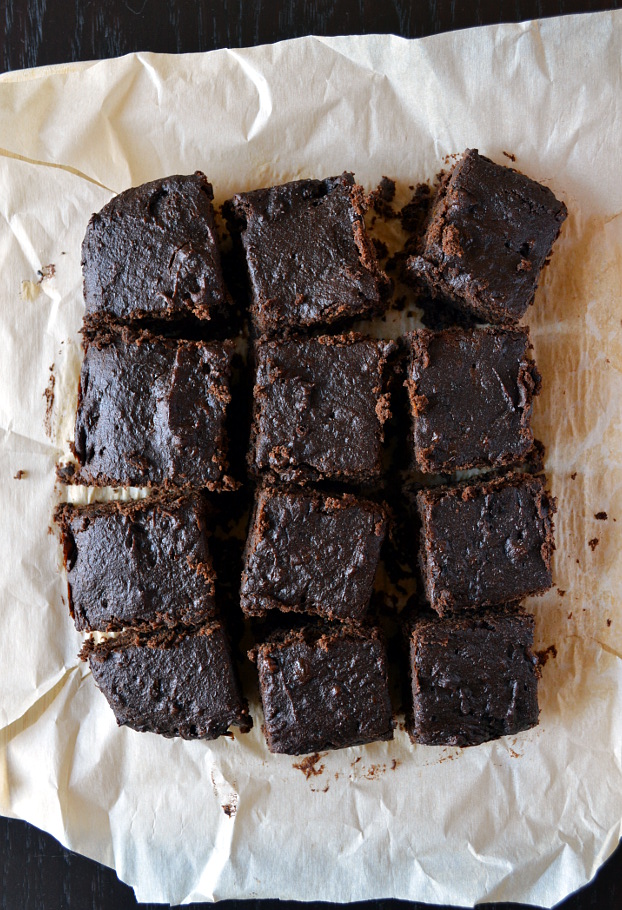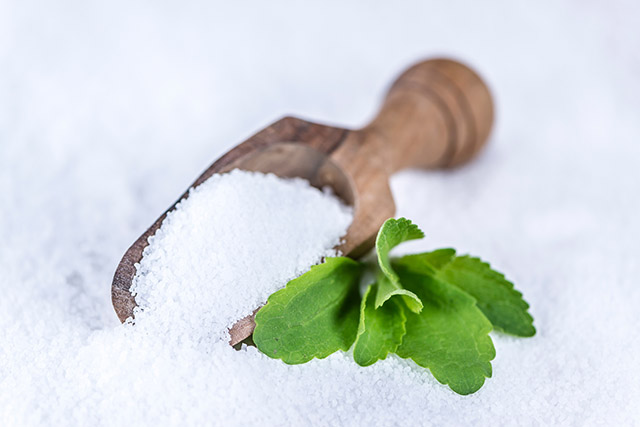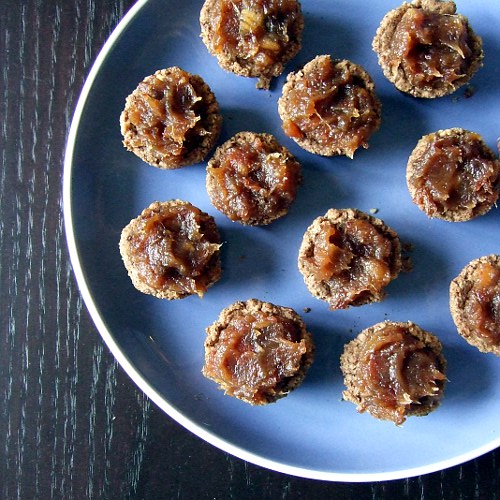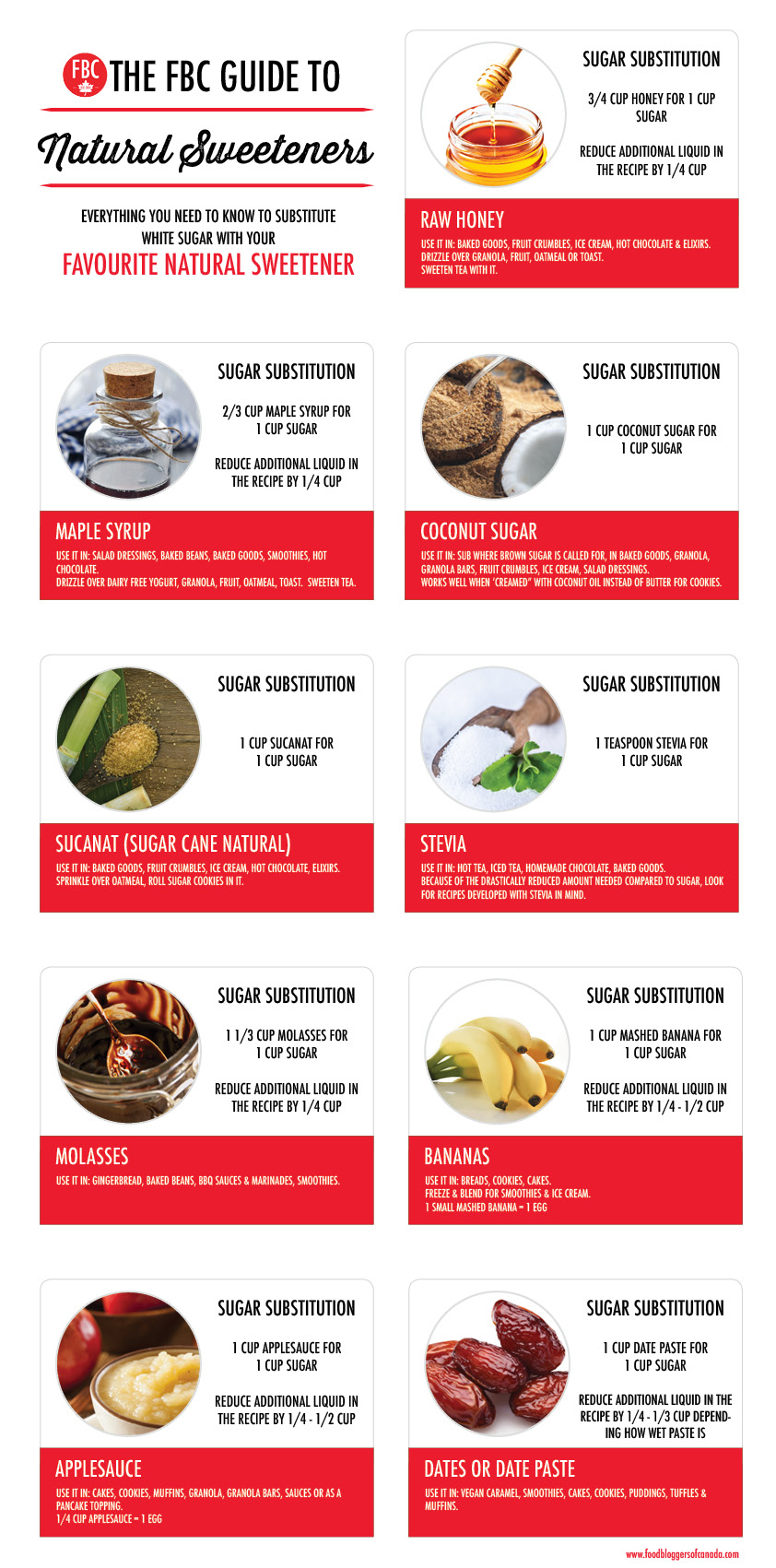What do you do when you’ve been diagnosed with a food allergy and your favourite foods are taken away? Fear not! Each month FBC member and certified nutritionist, Sondi Bruner, takes a look at how to adapt to an allergen-friendly diet, while still eating delicious and healthy food. This month she demystifies the wide range of natural sweeteners available to us.

The foods on the shelves today would make our great-grandparents' heads spin, but few aisles would be more confusing for them than the one with sweeteners.
White sugar is a pantry item that's been used for generations, but research is piling up to show that white, refined sugar is harmful to our health. It's a highly addictive substance that has been linked to a variety of serious conditions, including obesity, diabetes, metabolic syndrome, heart disease, cancer, non-alcoholic fatty liver disease, cancer and more.
And we're not just consuming sugar in cake and cookie form, where we'd expect it to be — added sugars are creeping into many food items such as breads, cereals, sauces, dressings, yogurt, snack bars and soups. A recent survey of packaged foods in the United States found that 60 percent of them contained added sugar. This problem of added sugars prompted the FDA in the United States to design a new nutrition label template that includes a line to identify them. In Canada, there is no such comparable research. The most recent is a 2004 sugar consumption survey, which declared we eat, on average, 26 teaspoons of sugar per day, but added sugars were not included in this research.
So what are those of us with a sweet tooth supposed to do? Forgo all treats and have kale salads for dessert?
Not necessarily. There are many natural sweeteners we can use instead that are more nutritious than their white sugar counterparts. In this post, I'll share some popular natural sweetener options and how to use them.
Before we get started, a couple of things to note.
- Natural sweeteners, as you'll see below, contain beneficial nutrients. But they are a form of sugar. Natural sweeteners are a healthier option; this doesn't mean you should eat dairy-free, honey-sweetened ice cream or gluten-free chocolate chip cookies every single night. However, if I'm going to be eating (or making) a treat, I aim to make it as nutritious and nutrient-dense as I can. This includes using natural sweeteners, and also whole-grain fibrous flours, nuts, seeds and healthy fats, which will all help to lower the glycemic load and be more satisfying, so I'll eat less of them.
- If you're buying or making treats for vegans, not all natural sweeteners are vegan; sugar can be processed with animal byproducts, such as bone char filters. The package should tell you if the sweetener you're buying is vegan or not. Also, some vegans consume honey while others don't, so it's best to double check with your favourite vegan!
- Generally, substitute dry sweeteners for dry sweeteners and wet sweeteners for wet sweeteners in recipes. This will help maintain the proper consistency and texture.
You can download a handy PDF version of our Complete Substitution Guide for Natural Sweeteners at the bottom of this post!
Raw Honey

Raw honey is packed with enzymes that help with digestion, amino acids, antioxidants, vitamins and minerals such as iron, calcium and potassium. It has anti-bacterial, anti-fungal and anti-viral properties, which means that it can soothe infections, boost immunity and even be used topically for skin wounds. To glean these benefits, ensure the honey you are using is raw, as processing and pasteurization destroys much of its healthful properties.
Use it in: Baked goods, fruit crumbles, ice cream, hot chocolate, elixirs, drizzle over dairy-free yogurt, gluten-free granola, fruit, oatmeal or toast, homemade chocolate, sweeten teas with it
Substitution Ratio: 3/4 cup honey for 1 cup sugar, reduce liquid by 1/4 cup
Maple Syrup

This Canadian staple (in fact, we produce 85 percent of the world's supply) is tapped from maple trees and has an abundance of nutrients like potassium, magnesium, phosphorus, manganese, iron, zinc, copper and calcium. Not only does maple syrup contain antioxidants, but it also has zinc, which is great for your heart, wound healing and the immune system.
Use it in: Salad dressings, baked beans, baked goods, smoothies, hot chocolate, drizzle over dairy-free yogurt, gluten-free granola, fruit, oatmeal, or toast, homemade chocolate, sweeten teas with it
Substitution Ratio: 2/3 cup maple syrup for 1 cup sugar, reduce liquid by 1/4 cup
Coconut Sugar

This low-glycemic sweetener comes from the blossoms of the tropical coconut palm tree. It's rich in a wide array of vitamins and minerals, especially potassium, magnesium, zinc, iron, B vitamins and Vitamin C. It has a mild caramel flavour, and I often use it as a replacement when a recipe calls for brown sugar. Coconut nectar has the same nutrient profile as coconut sugar, except it's in a gooey, liquid form.
Use it in: I use coconut sugar anytime brown sugar is called for. It works well when 'creamed' with coconut oil instead of butter for cookies, and it's great in baked goods, granola, granola bars, fruit crumbles, ice cream and salad dressings.
Substitution Ratio: 1 cup coconut sugar for 1 cup sugar
Sucanat (Sugar Cane Natural)

Sucanat is made from crushed sugar cane stalks from which the juice is extracted, then heated and dried into granules. Since nothing is removed in the process, it contains iron, calcium, B vitamins and potassium.
Use it in: Baked goods, fruit crumbles, ice cream, hot chocolate, elixirs, sprinkle over oatmeal, roll sugar cookies in it
Substitution Ratio: 1 cup sucanat for 1 cup sugar
Stevia

Derived from the stevia plant, stevia is actually 10 to 15 times sweeter than sugar — only one small teaspoon of it equals an entire cup of sugar! It's low-glycemic, and it even has anti-bacterial and anti-fungal properties, too. I recommend buying stevia that comes as a green powder (the stevia plant is green), because white or liquid stevia has been through refining and processing. I thought I didn't like stevia, but once I had treats using the green powder I realized that stevia doesn't actually taste like chemicals.
Use it in: Hot tea and iced tea, homemade chocolate, baked goods. Since you need to use a drastically reduced amount of stevia compared to sugar, I recommend using recipes that have been designed with stevia in mind.
Substitution Ratio: 1 tsp stevia for 1 cup sugar
Molasses
Blackstrap molasses is a by-product of the processing of sugar cane into refined white sugar. Producers extract what they need to make white sugar, and the rest is boiled down to create molasses. But don't let its association with white sugar deter you, because blackstrap molasses has all the stuff white sugar doesn't. It's extremely rich in iron and calcium, as well as copper, potassium and magnesium.
Fancy molasses is sugarcane juice inverted into a syrup - kind of like how maple syrup is made (and it contains more nutrients than maple syrup) I tend to buy blackstrap molasses, which has a very strong flavour, but you can also purchase fancy, cooking (a mix of fancy and blackstrap) or light molasses. Discover the difference here.
Use it in: Gingerbread, baked beans, BBQ sauces and marinades, smoothies
Substitution Ratio: 1 1/3 cup molasses for 1 cup sugar, reduce liquid by 1/4 cup
Bananas
Mashed overripe bananas are a great natural sweetener and, as a whole food, they offer us a dose of fibre, Vitamin C, potassium and Vitamin B6, which is responsible for the health of our blood, brain and nervous system. While many bakers like to use bananas to replace fat in a recipe, I prefer to use them instead of sugar. They're also commonly swapped for eggs to create vegan recipes.
Use it in: Breads, cookies, cakes, freeze and blend for smoothies and ice cream
Substitution Ratio: 1 cup of mashed bananas for 1 cup of sugar, reduce liquid by 1/4 to 1/2 cup. One small mashed banana for 1 egg.
Applesauce

Similar to bananas, apples are a great source of Vitamin C and fibre, which supports the digestive tract, cardiovascular system and helps us manage blood sugar levels. Plus, applesauce is easy to make. I recommend leaving the skins on, as apple skins have a high concentration of nutrients such as quercetin, which helps us fight seasonal allergies. And think of the work you'll save on peeling! Applesauce is another one that bakers like to swap for oil, and because of its pectin content it's a good vegan egg replacer.
Use it in: Cakes, cookies, muffins, granola, granola bars, sauces, as a pancake topping
Substitution Ratio: 1 cup applesauce for 1 cup sugar, reduce liquid by 1/4 to 1/2 cup. 1/4 cup applesauce for 1 egg.
Dates/Date Paste

This simple paste is a breeze to make: soak pitted dates in water, then whirl them in your blender or food processor. You can make the consistency as thick or thin as you like, and use the paste in everything from cakes and cookies to puddings and truffles. Dates are an excellent source of fibre, and they've got minerals like potassium, calcium, iron and magnesium, as well as plenty of B vitamins to help with energy. Dried prunes and figs also make great pastes!
Use it in: Vegan caramel, smoothies, cakes, cookies, puddings, truffles, muffins
Substitution Ratio: 1 cup date paste for 1 cup sugar, you may need to reduce liquid by 1/4 to 1/3 cup depending on how wet your date paste is
Agave Nectar
I'm not so crazy about this alternative. Agave is very high in fructose, and is often so refined that some experts say that it's no better for us than sugar or high fructose corn syrup. Fructose is a naturally-occurring sugar in fruits and vegetables and when we eat it in a whole food, like a carrot, vitamins, minerals and fibre come along for the ride. But when we extract the fructose from its natural source, it becomes very difficult for our bodies to metabolize, putting us at risk of insulin resistance, high triglycerides, acidity, non-alcoholic fatty liver disease and obesity. Agave nectar isn't something I use in my own cooking or baking, but I occasionally have it if I'm out at a restaurant or bakery.
Use it in: Candies, baked goods, iced drinks or elixirs, cocktails, chocolate
Substitution ratio: 2/3 cup agave for 1 cup sugar, reduce liquid by 1/4 to 1/3 cup
Brown Rice Syrup
As the name suggests, brown rice syrup comes from brown rice that has been broken down and filtered. While it has some trace minerals, brown rice doesn't offer us much nutrition-wise. Similar to agave nectar, brown rice syrup is high-glycemic and has a similar affect on the body as white sugar or high fructose corn syrup. There is also some concerns about arsenic levels: one study of packaged foods (even organic ones) contained high amounts of arsenic.
Use it in: For strict vegans, brown rice syrup can simulate the texture and consistency of honey. However, coconut syrup can also have this effect.
Substitution Ratio: 1 1/4 cup brown rice syrup for 1 cup sugar, reduce liquid by 1/4 cup
Xylitol
Xylitol belongs to a class of sweeteners called 'sugar alcohols', which are often used by diabetics or people with blood sugar issues because they don't cause a dramatic rise in blood glucose levels. Xylitol is also used in toothpastes and gums because it's been shown to improve dental health. It's sweetness is concentrated so you can use less, which is a good thing, because too much xylitol can cause bloating, gas and diarrhea. Warning: xylitol is poisonous to dogs.
Substitution Ratio: 1 cup xylitol for 1 cup sugar
If you're nervous about substituting sugar in your favourite recipes, start off by replacing half of the white sugar with an alternative and move on from there. Everyone's tastes vary, so have fun experimenting with new sweeteners and see which ones satisfy your palette. Personally, I favour raw honey and maple syrup because I can purchase them locally (and I also happen to love their flavours!).
Quick Guide to Natural Sweetener Substitutions

Download your own PDF copy of the FBC Guide to Substituting Natural Sweeteners. You can print it out and put it on your fridge for easy access while cooking or keep it on your laptop or tablet!
What natural sweeteners do you love to use, and how do you prefer to use them? Please share in the comments!
- ¾ cup gluten-free rolled oats
- ¾ cup almond flour
- 3 tbsp coconut oil
- ¼ cup maple syrup
- ¼ cup dried cranberries, roughly chopped into smaller bits
- 2 tbsp cacao nibs, optional
- ½ tsp cinnamon
- pinch of salt
- Preheat the oven to 350 degrees F.
- Put the rolled oats in a blender, food processor or spice grinder and pulse until the oats are ground into a meal. Dump the ground oats into a bowl and add the almond flour, cinnamon and salt. Mix well.
- Drop the coconut into the bowl and mash it into the flours with the back of a spoon. The mixture will be crumbly. Pour the maple syrup in and mix well.
- Stir in the cranberries and cacao nibs, if using.
- Line a baking sheet with parchment paper or a silpat. Using a ¼-cup measure, scoop the cookies onto the baking sheet and flatten them to about ½-inch thick (I used the back of my measuring cup to flatten them).
- Bake for 15 minutes. Makes six cookies.
More Reading
Check out more of Sondi’s Allergen-Friendly Remixes for great ideas on revamping your favourite recipes to make them allergen friendly!
- The FBC Guide to Using Gluten-Free Flours
- Animal Products
- Vegan and Gluten-Free Pies and Tarts
- Dips and Spreads
- Potato Salad
Sondi Bruner is a holistic nutritionist, freelance writer and food blogger. She educates people who follow allergen-friendly diets about how to eat simply, deliciously and safely, allowing them to rediscover the pleasure of food. When she’s wearing her writer’s hat, she works with natural health brands to create content that will help their customers live fulfilling, healthful lives. Find out more at www.sondibruner.com. Or you can follow Sondi on Facebook or Twitter.








Excellent Read Sondi!
I just love all the natural sweetener alternatives you mentioned here. Banana, Dates, Stevia and Honey are my favorites. they are natural and healthy for consumption.
I have bookmarked your info-graphic and might just this recipe in my posts as well. 🙂